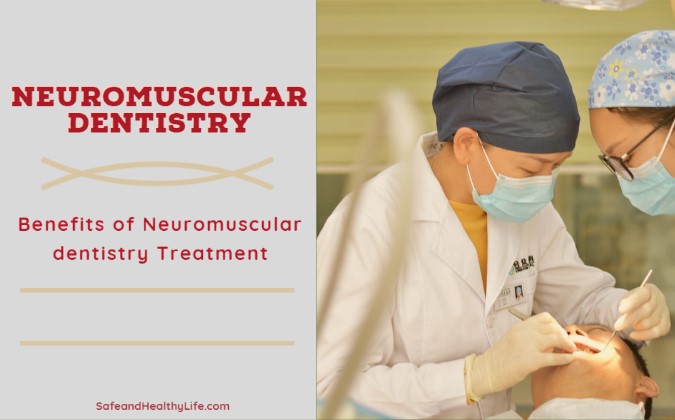
Neuromuscular dentistry is a form of dental treatment that focuses on the jaw.
It determines the perfect arrangement of teeth in the mouth in order for them to be able to correct misalignment.
“Neuromuscular Dentistry is the expanded form of traditional dentistry”
Jaw plays an important role in chewing, grinding and swallowing. Any problems with jaw muscles can be extremely painful. Neuromuscular dentistry provides solutions to these problems.
Temporomandibular joint disorder (TMD)
In addition to adapting the manner in which the teeth come together. Simply by realigning the chin joint through the use of cosmetic dental corrections, tooth recontouring or orthodontics, Scott Young, DDS makes an effort to alleviate stress from your jaw muscle groups and eradicate agonizing associated with the temporomandibular joint disorder.
Studies show disorders related to cervical spine/posture can be associated with Neuromuscular dentistry and needs to be thoroughly investigated.
What differentiates neuromuscular dentistry from other theories associated with is its emphasis on gravity such as figuring out the bite, because well as the location where the jaw muscles are usually most relaxed.
Benefits of Neuromuscular dentistry Treatment
Neuromuscular dentistry can be used on a number of situations but most important are:
- If you are planning to rebuild your teeth or restructure them
- Alignment problems in jaws
- Bite or Deep Bite Problems, injuring mouth soft tissues
- If your feeling Tinnitus i.e. Ringing in the Ear)
- If you are suffering from headache and/or pains in the upper part of your body i.e. neck pain
- If you have a Temporomandibular joint disorder TMD or another jaw issue
Neuromuscular dentistry provides satisfactory solutions to the above problems and finds the root cause of the problem whether it can be muscle joints, jaws, gums or teeth.
| Read also: How Sedation Dentistry Help Patients to Relax During Treatment |
History of Neuromuscular Principle
Neuromuscular dentistry has been introduced in the particular late 1960s/early 1970s by Dr. Bernard Jankelson, who analyzed the relationship in the upper and reduced jaws.
Nevertheless, this individual did not restrict his examination to each tooth, but also looked into the relationship among the particular muscles, nerves, bone fragments and two temporomandibular joints (TMJs).
Together with the assistance of his son, Doctor Bob Jenkelson, developed equipment to discover the ideal place from the lower chin, that was determined in order to find the location where the mouth muscles are most comfortable.
According to Doctor Jankelson, in addition to neuromuscular theory, any time the teeth, chin muscles, and TMJs are not in-line, TMD symptoms occur to indicate this.
Diagnosis
1. X-rays:
X-rays can be used for diagnosis of teeth and jaw issues and they provide an accurate picture, positioning, and structure of teeth and jaws.
In add-on to X-rays or even digital radiographs of which reveal the position in addition to the condition of the particular jaw joints, dental surgeons use several classification technologies in purchase to determine the ideal position of the jaw to relieve TMD symptoms.
These types of technologies include:
Electronic equipment to record the resting position of a person’s mouth, how it closes and any additional movements.
2. Electromyography (EMG)
Electromyography (EMG) to measure the anxious and relaxed opportunities of a missing word jaw muscles, along with identifying any strength defects in typically the jaw joint sonography, and/or Joint Vibration Analysis to document jaw joint noises and determine typically the presence of malocclusions.
3. Sonography
Sonography work by recording the jaw joint sounds and oral vibrations.
Treatment Options
If the jaw is not properly aligned, neuromuscular dental care may help to address the precise root cause of the issue – whether jaw shared, muscle or dental position.
Treatment plans developed by dentists are designed in order to correct bite malocclusions by allowing the jaws to go to their optimal positions in line with the long-expression.
Transcutaneous Electrical Nerve Stimulation(TENS):
Also known as Transcutaneous Electrical Nerve Stimulation, this method uses electrical stimulation to:
- relax your jaw muscles
- relieve pain associated with jaws
- muscle spasms/inflammations
- abnormal misaligned jaw positions.
So during the treatment dental surgeons assert that muscle tissue pain and spasms can be relieved using Ultra Lower Frequency Transcutaneous Power Nerve Stimulation (ULF-TENS).
This treatment involves putting electrodes on your current jaw, neck plus shoulder areas that transmit mild power stimulation to frequently contract the jaw muscles in order to rest them.
Oral Appliances
Adjustments to be able to a person’s bite can be completed utilizing a piece of oral equipment, such as a splint or perhaps a mouth guard until the nip continues to be permanently stabilized. Or, an orthodontic function can be required to be able to ensure proper positioning, in addition, performing dental restoration such as crowns, or perhaps tooth recontouring (equilibration).
Other treatment options include Ultrasounds and Trigger-point injections, particularly for TMDs.
Cost of Treatment
The cost regarding neuromuscular treatment will depend on your scientific condition and the processes necessary to deal with your condition, the particular expertise of the dentist, the location of the dentist, in addition to the type of dental insurance coverage you have.
Need to remember that in neuromuscular treatments full mouth reconstruction can be required and minimum cost could be around $1000 to $1,500 per tooth. excluding any charges for dental / mouth surgery or any other oral treatment.
Full mouth reconstruction can cost up to $40, 000 or more.
About The Author:
My name is Wahab. My interest is sharing different ideas and tips. I like to share ideas and as a result, I would be delighted to hear from you.
